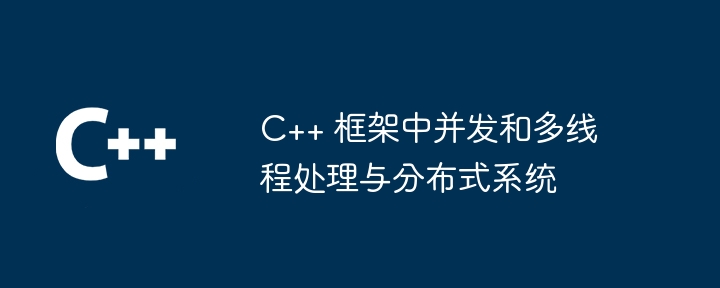在 c++++ 框架中,并发和多线程处理对于复杂任务至关重要。通过利用 std::thread 和 std::async 类实现多线程,分布式系统可用于更复杂的任务处理。流行的 c++ 框架包括 boost.asio、c++ rest sdk 和 apache cassandra,通过示例说明了分布式 c++ 系统中并发性和多线程的应用。

C++ 框架中的并发和多线程处理与分布式系统
概述
在现代软件开发中,并发和多线程处理对于处理复杂且时间敏感的任务至关重要。C++ 框架提供了强大的工具和技术,使开发人员能够充分利用这些功能。此外,分布式系统正在日益普及,因此了解如何将并发性和多线程性与分布式系统相结合也很重要。
“C++”;
并发和多线程
并发是指同时执行多个任务的能力。多线程是实现并发的常见技术,其中多个线程同时执行相同的程序的不同部分。C++ 中的线程可以通过 std::thread 类和 std::async 函数来创建和管理。
1
2
3
4
5
6
7
// 创建和启动线程
std::thread thread1([]() { ... });
thread1.join();
// 使用 std::async 异步执行任务
auto future = std::async([]() { return sqrt(2.0); });
double result = future.get();
分布式系统
分布式系统是跨多个计算机或节点组合在一起以处理更复杂任务的大型系统。分布式系统中的并发性需要考虑网络延迟、消息传递和容错等问题。
C++ 框架
C++ 中有几个流行的框架可用于并发和分布式系统处理,包括:
Boost.Asio: 用于编写高性能网络应用程序的跨平台库。C++ REST SDK: 用于构建 RESTful Web 服务和客户端的现代框架。Apache Cassandra: 高度可扩展且高可用性的分布式 NoSQL 数据库。实战案例
以下是一个在分布式 C++ 系统中使用并发性和多线程的示例:
1
2
3
4
5
6
7
8
9
10
11
12
13
14
15
16
17
18
19
20
21
22
23
24
25
26
27
28
29
30
31
32
33
34
35
36
37
38
39
40
41
42
43
44
45
46
47
// 分布式任务队列
class TaskQueue {
public:
std::vector<std::thread> threads;
std::queue<std::function<void()>> tasks;
TaskQueue(int numThreads) {
for (int i = 0; i < numThreads; i++) {
threads.push_back(std::thread([this]() {
while (true) {
std::function<void()> task;
{
std::unique_lock<std::mutex> lock(mtx);
if (!tasks.empty()) {
task = std::move(tasks.front());
tasks.pop();
}
}
if (task) {
task();
} else {
break;
}
}
}));
}
}
void addTask(std::function<void()> task) {
std::unique_lock<std::mutex> lock(mtx);
tasks.push(task);
}
void stop() {
for (auto& thread : threads) {
thread.join();
}
}
private:
std::mutex mtx;
};
// 在客户端进程中
TaskQueue queue(4);
queue.addTask([]() { / 执行任务 / });
queue.stop();
结论
通过利用 C++ 框架中的并发和多线程处理技术,开发人员可以构建高效且可扩展的软件系统。这些技术对于处理分布式系统中的复杂任务尤其重要。
以上就是C++ 框架中并发和多线程处理与分布式系统的详细内容,更多请关注其它相关文章!
